|
|
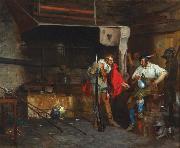 |
Eduardo Zamacois Y Zabala
|
|
Eduardo Zamacois y Zabala (ca. 1841 - 14 January 1871) was a Spanish academic painter who was born in Bilbao, Spain in 1841 or 1842. He moved to Madrid in 1859, where he enrolled in the Real Academia de Bellas Artes de San Fernando and studied with Federico de Madrazo. In 1860, he studied in Paris with Jean-Louis-Ernest Meissonier (1815-1891). He achieved success at the Paris Salon of 1867 with Buffon au 16e siecle.
Zamacois y Zabala is associated with both classicism and anti-clerical art. He is known to have employed the Swiss painter Edouard Castres (1838-1902) as his assistant. He died in Madrid in 1871 at the age of 29.
|
|
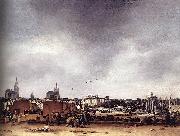 |
Egbert van der Poel
|
|
Egbert van der Poel (Delft, 1621 - Rotterdam, 1664) was a Dutch Golden Age genre and landscape painter, son of a Delft goldsmith.
He may possibly have been a student of Esaias van de Velde and of Aert van der Neer. According to the RKD he was the brother of the painter Adriaen Lievensz van der Poel and a student of Cornelis Saftleven in Rotterdam. Van der Poel was registered with the Guild of St Luke in Delft on October 17, 1650, where he is listed as a landscape painter. In 1651 van der Poel married Aeltgen Willems van Linschooten in Maassluis, near Rotterdam. His most famous paintings depict the Delft gunpowder explosion of October 12, 1654 and its aftermath; he and his wife were living in the area at the time. Egbert and Aeltgen van der Poel had a son and three daughters. He died in Rotterdam in 1664. |
|
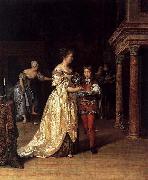 |
Eglon van der Neer
|
|
(1635/36, - May 3, 1703), was a Dutch painter of historical scenes, portraits and elegant, fashionable people, and later of landscapes.
Van der Neer was born in Amsterdam and was probably first taught by his father, Aert van der Neer, who married in Amsterdam in 1629, coming from Gorinchem. Eglon had a least five brothers and sisters, who were baptized in the Nieuwe Kerk between 1640 and 1650. He took lessons from Jacob van Loo, who was then one of the foremost figure painters in Amsterdam. Around 1654 Van der Neer, who probably had just finished his education with Van Loo, traveled to Orange, Vaucluse in the South of France and entered the service of Friedrich von Dohna (1621-1688), Governor of the Principality of Orange. Van der Neer stayed for three or four years in Orange and returned to Amsterdam by the end of 1658. There he married in February Maria Wagensvelt, the daughter of a wealthy Rotterdam notary. In 1663 Van der Neer and his family moved to Rotterdam, where Adriaen van der Werff became his student. He stayed in Rotterdam until his wife died in 1677. In 1679 he moved to The Hague and in 1680 he became a member of the Confrerie Pictura there. Later that year he moved again, taking up his residence at Brussels, where he married the miniature painter Marie Du Chastel in the following year. She bore him nine children.
|
|
|
|
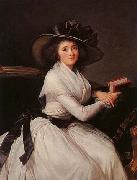 |
eisabeth Vige-Lebrun
|
|
(Marie Élisabeth Louise; 16 April 1755 - 30 March 1842) was a French painter, and is recognized as the most famous female painter of the 18th century. Her style is generally considered Rococo and shows interest in the subject of neoclassical painting. Vigee Le Brun cannot be considered a pure Neoclassist, however, in that she creates mostly portraits in Neoclassical dress rather than the History painting. In her choice of color and style while serving as the portrait painter to Marie Antoinette, Vigee |
|
|
|
 |
Elihu Vedder
|
|
American Symbolist Painter, 1836-1923
American painter, illustrator, sculptor and writer. He studied under Tompkins Harrison Matteson in Shelbourne, NY, and went to Paris in March 1856. After eight months in the studio of Fran?ois-Edouard Picot, he settled in Florence until the end of 1860. There he learnt drawing from Raffaello Bonaiuti, became interested in the Florentine Renaissance and attended the free Accademia Galli. A more significant artistic inspiration came from the Italian artists at the Caff? Michelangiolo: Telemaco Signorini, Vincenzo Cabianca (1827-1902) and especially Nino Costa (1827-1902). This group sought new and untraditional pictorial solutions for their compositions and plein-air landscapes and were particularly interested in the experiences of Gustave Courbet and the Barbizon painters. They became known as Macchiaioli for their use of splashes (macchia) of light and shadows and for their revolutionary (maquis) attitude to prevailing styles. Among Vedder's most notable Florentine landscapes are Mugnone Torrent near Fiesole (Detroit, MI, Inst. A.) and Le Balze, Volterra (Washington, DC, N. Mus. Amer. A.) |
|
|
|
|
|
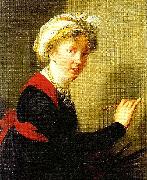 |
elisabeth vigee-lebrun
|
|
Élisabeth-Louise Vigee-Le Brun, född 16 april 1755 i Paris, död 30 mars 1842 i Louveciennes, 20 kilometer väster om Paris, var en fransk målare som i huvudsak målade porträtt.
Vigee-Lebrun utförde tilldragande, idealiserande porträtt och var för en tid hovmålare hos drottning Marie Antoinette. Vigee-Lebrun var tvungen att lämna Frankrike pågrund av den franska revolutionen 1789 och efter det var hon verksam i Ryssland, Italien och Storbritannien. Efter att Napoleons kommit till makten återvände hon till Frankrike. Hon besökte Schweiz 1807 där hon i Geneve blev invald som hedersmedlem i Societe pour l'Avancement des Beaux-Arts.
Vigee-Le Brun lämnade ett arv av 660 porträttmålningar och 200 landskapsmålningar. Dessa finns i privata samlingar i Europa och USA men även i stora museer som Eremitaget, National Gallery i London, Metropolitan Museum of Art i New York och National Gallery of Art i Washington, D.C.. |
|
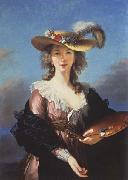 |
Elisabeth-Louise Vigee-Lebrun
|
|
1755-1842
was a French painter, and is recognized as the most famous woman painter of the eighteenth century. Her style is generally considered Rococo and shows interest in the subject of neoclassical painting. Vigee-Le Brun cannot be considered a purely Neoclassist in that she creates mostly portraits in Neoclassical dress rather than the History painting. In her choice of color and style while serving as the portrait painter to the Queen, |
|
 |
Eliseu Visconti
|
|
1867-1944
Eliseu Visconti Gallery
Brazilian painter and decorative artist, of Italian birth. He was taken as an infant from Italy to Rio de Janeiro. In 1884 he began studying in Rio de Janeiro at the Academia Imperial das Belas Artes and the Liceu Imperial de Artes e Of?cios under Victor Meirelles de Lima, Henrique Bernardelli (1837-1946) and Rodolfo Amoedo (1857-1941). He was active in efforts to eliminate the academy's rigid academic discipline. He went to Paris in 1892 and attended the Ecole des Beaux-Arts and the Ecole des Arts D?coratifs, where he was taught by Eug?ne-Samuel Grasset. At the 1900 Exposition Universelle in Paris, Visconti won a silver medal for the paintings Youth (1898) and Dance of the Wood Nymphs (1899; both Rio de Janeiro, Mus. N. B.A.). Following the Pre-Raphaelites, his main influences were Botticelli and other painters of the Italian Renaissance, but he was also affected by Grasset and Art Nouveau. On his return to Brazil, among the works exhibited in 1901 in Rio de Janeiro were a series of ceramic objects with Brazilian floral motifs and designs for postage stamps. His florid style began to give way to Impressionism in the stage curtain, circular ceiling panel and proscenium frieze he executed for the Rio de Janeiro Teatro Municipal (1906-7; in situ). In 1906 he became director of painting at the Escola Nacional de Belas Artes in Rio de Janeiro. |
|
|
|
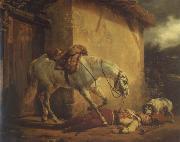 |
Emile Jean Horace Vernet
|
|
French, 1789-1863,Painter, son of Carle Vernet. He was born in his father's lodgings at the Palais du Louvre, where his grandfather Joseph Vernet also lived; his maternal grandfather was Jean-Michel Moreau. To these antecedents and influences are ascribed the supreme ease of his public career, his almost incredible facility and his fecundity. His early training in his father's studio was supplemented by formal academic training with Francois-Andre Vincent until 1810, when he competed unsuccessfully for the Prix de Rome. He first exhibited at the Salon in 1812. In 1814 Vernet received the Legion d'honneur for the part he played in the defence of Paris, which he commemorated in the Clichy Gate: The Defence of Paris, 30 March 1814. |
|
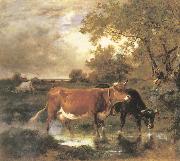 |
Emile Van Marcke de Lummen
|
|
1827-1890
Emile van Marcke was born in S??vres - into a family of artists. His father was Jean-Baptiste (1797-1848), the eldest son of Charles van Marcke and a painter who specialized not only in landscape and animal paintings, but also works on porcelain. |
|
|
|
|
|
|
|
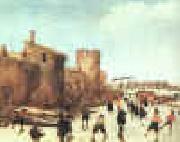 |
Esaias Van de Velde
|
|
1591-1630
Dutch
Esaias Van de Velde Gallery
Painter, draughtsman and etcher. He probably received his earliest training from his father. It is also possible that he studied with the Antwerp painter Gillis van Coninxloo, who moved to Amsterdam in 1595 (ten years after Esaias father). He may also have trained with David Vinckboons, whose work shows similarities with that of Esaias. Esaias became a member of the Haarlem Guild of St Luke in 1612, the same year as Willem Buytewech and the landscape painter Hercules Segers. During this Haarlem period Esaias had two pupils, Jan van Goyen and Pieter de Neijn (1597-1639), but by 1618 he had moved with his family to The Hague, where he joined the Guild of St Luke in October of that year. |
|
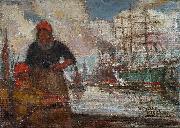 |
Eugeen Van Mieghem
|
|
(1 October 1875-1930) was a Belgian artist born in the port of Antwerp. As a boy Van Mieghem was confronted with the harsh reality of life at the waterfront.
Even at primary school he showed a talent for drawing. He was introduced to the work of Vincent van Gogh, Georges Seurat, Camille Pissarro, Henri de Toulouse-Lautrec and others at an exhibition organised by Flemish painter and architect Henry van de Velde at the Antwerp Academy around 1892. He attended the Antwerp Academy but was sent from school because his conservative teachers disliked his subject matter and his free, spontaneous way with it. He threw his lot in with progressive political and cultural movements, and joined an anarchist group. By the early 1900s was recognized as one of the most promising young artists of the Antwerp school. He would never renounce his idealism. He became the artist of the typical harbour folk: sack porters, sack makers, emigrants, dockers, bargees, and tramps.
Van Mieghem had his first taste of real success at La Libre Esthetique in Brussels, where his pastels and drawings hung alongside works by French impressionists such as Claude Monet, Paul Cezanne, Camille Pissarro, Jean Renoir and Edouard Vuillard.
|
|
|
|
|
|
|
|
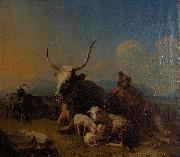 |
Eugne Joseph Verboeckhoven
|
|
(1790-1881), Belgian painter, was born at Warneton in West Flanders, and received instruction in drawing and modelling from his father, the sculptor Barthelemy Verboeckhoven. Subsequently he settled in Brussels and devoted himself almost exclusively to animal subjects.
Shepherd with animals in the countryside
attributed to Eugene Verboeckhoven - private collectionHis paintings of sheep, of horses and of cattle in landscape, somewhat after the manner of Paulus Potter, brought him universal fame, and were eagerly sought for by collectors. Precise and careful finish is the chief quality of his art, which is entirely objective and lacking in inspiration. Verboeckhoven visited England in 1826, Germany in 1828, and France and Italy in 1841, and died at Brussels in 1881. He was a member of the academies of Brussels, Ghent, Antwerp, St. Petersburg and Amsterdam. Examples of his art are to be found in nearly all the important galleries of Europe and the United States, notably in Brussels, Antwerp, Amsterdam, Hamburg, Berlin, Munich, New York, Boston and Washington D.C.. His long life and ceaseless industry account for the enormous number of his pictures in public and private collections and in the art market. In addition to his painted work he executed some fifty etched plates of similar subjects.
|
|
 |
Evariste Vital Luminais
|
|
(October 13, 1822 - 1896) was a French painter.
He was born in Nantes. He scored a success at the Paris Salon of 1884 with the painting Flight of King Gradlon. Another Luminais' important painting is The Sons of Clovis II.
|
|
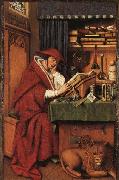 |
EYCK, Jan van
|
|
Flemish Northern Renaissance Painter, ca.1395-1441
Painter and illuminator, brother of Hubert van Eyck. According to a 16th-century Ghent tradition, represented by van Vaernewijck and Lucas d'Heere, Jan trained with his brother Hubert. Pietro Summonte's assertion (1524) that he began work as an illuminator is supported by the fine technique and small scale of most of Jan's works, by manuscript precedents for certain of his motifs, and by his payment in 1439 for initials in a book (untraced) for Philip the Good, Duke of Burgundy. Jan is first documented in The Hague in August 1422 as an established artist with an assistant and the title of 'Master', working for John III, Count of Holland (John of Bavaria; reg 1419-25), who evidently discovered the artist while he was bishop (1389-1417) of the principality of Liege. |
|
|
|
|
|
 |
Felix Vallotton
|
|
French
1865-1925
Felix Vallotton Gallery
Swiss woodcut artist and painter. Associated with the Nabis, he worked in Paris. Vallotton rejuvenated the woodcut medium as a creative technique. His boldly cut designs, conceived as arrangements in black and white, depict Parisian society with wit and intelligence. A painting, Swiss Landscape, is in the Lyman Allyn Museum, New London, |
|
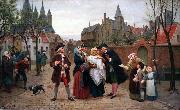 |
Felix de Vigne
|
|
(16 March 1806 - 5 December 1862) was a Belgian painter.
De Vinge was a history painter, engraver, art historian, and instructor at the Royal Academy of Fine Arts (Ghent). In 1847 he published Recherches historiques sur les costumes civils et militaires, an illustrated compendium of the flags, shields and costumes of medieval guilds and military groups.
He was the brother of sculptor Pieter De Vigne (1812-1877), father of Brussels architect Edmond De Vinge (1841-1918), and the stepfather of painter Jules Breton.
|
|
|
|
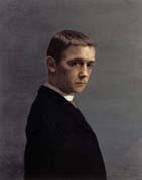 |
Felix Vallotton
|
|
1865-1925was a Swiss painter and printmaker associated with Les Nabis. He was an important figure in the development of the modern woodcut. He was born into a conservative middle class family in Lausanne, and there he attended College Cantonal, graduating with a degree in classical studies in 1882. In that year he moved to Paris to study art under Jules Joseph Lefebvre and Gustave Boulanger at the Academie Julian. He spent many hours in the Louvre, where he greatly admired the works of Holbein, Derer and Ingres; these artists would remain exemplars for Vallotton throughout his life.[1] His earliest paintings, such as the Ingresque Portrait of Monsieur Ursenbach (1885), are firmly rooted in the academic tradition, and his self portrait of 1885 (seen at right) received an honorable mention at the Salon des artistes français in 1886. During the following decade Vallotton painted, wrote art criticism and made a number of prints. In 1891 he executed his first woodcut, a portrait of Paul Verlaine. The many woodcuts he produced during the 1890s were widely disseminated in periodicals and books in Europe as well as in the United States, and were recognized as radically innovative in printmaking. They established Vallotton as a leader in the revival of true woodcut as an artistic medium; in the western world, the relief print, in the form of commercial wood engraving, had long been mainly utilized unimaginatively as a medium for the reproduction of drawn or painted images and, latterly, photographs. Vallotton's starkly reductive woodcut style features large masses of undifferentiated black and areas of unmodulated white. While emphasizing outline and flat patterns, Vallotton generally made no use of the gradations and modeling traditionally produced by hatching. The influences of post-Impressionism, symbolism and the Japanese woodcut are apparent; a large exhibition of ukiyo-e prints had been presented at the École des Beaux-Arts in 1890, and Vallotton, like many artists of his era an enthusiast of Japonism, collected these prints. He depicted street crowds and demonstrations including several scenes of police attacking anarchists bathing women, portrait heads, and other subjects which he treated with a sardonic humor. His graphic art reached its highest development in Intimit's (Intimacies), a series of ten interiors published in 1898 by the Revue Blanche, which deal with tension between men and women. Vallotton's prints have been suggested as a significant influence on the graphic art of Edvard Munch, Aubrey Beardsley, and Ernst Ludwig Kirchner .By 1892 he was affiliated with Les Nabis, a group of young artists that included Pierre Bonnard, Ker-Xavier Roussel, Maurice Denis, and Edouard Vuillard, with whom Vallotton was to form a lifelong friendship. During the 1890s, when Vallotton was closely allied with the avant-garde, his paintings reflected the style of his woodcuts, with flat areas of color, hard edges, and simplification of detail. |
|
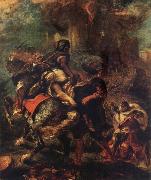 |
Ferdinand Victor Eugene Delacroix
|
|
Charenton Saint Maurice 1798-Paris 1863,was a French Romantic artist regarded from the outset of his career as the leader of the French Romantic school. Delacroix's use of expressive brushstrokes and his study of the optical effects of colour profoundly shaped the work of the Impressionists, while his passion for the exotic inspired the artists of the Symbolist movement. A fine lithographer, Delacroix illustrated various works of William Shakespeare, the Scottish writer Sir Walter Scott, and the German writer Johann Wolfgang von Goethe. In contrast to the Neoclassical perfectionism of his chief rival Ingres, Delacroix took for his inspiration the art of Rubens and painters of the Venetian Renaissance, with an attendant emphasis on color and movement rather than clarity of outline and carefully modeled form. Dramatic and romantic content characterized the central themes of his maturity, and led him not to the classical models of Greek and Roman art, but to travel in North Africa, in search of the exotic.Friend and spiritual heir to Theodore Gericault, |
|
|
|
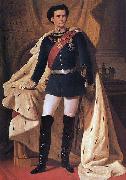 |
Ferdinand von Piloty
|
|
painted King Ludwig II of Bavaria in generals' uniform and coronation robe in 1865 |
|
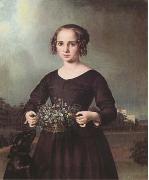 |
Ferdinand von Rayski
|
|
1806-1890
was a German painter noted for his portraits. Rayski was born in 1806 in Pegau. From 1816 to 1821 he studied drawing under Traugott Faber at the Freimaurerinstitut in Dresden and from 1823 to 1825 studied at Kunstakademie in Dusseldorf. He began his career as a professional artist in 1829, painting portraits of his noble relatives in Hannover and Silesia. From 1831 to 1834 he lived in Dresden, where he received numerous portrait commissions. He traveled to Paris in 1834-35, and was influenced by the works of Delacroix, Gericault and Gros. Rayski gained a reputation as a distinguished portrait painter, but also produced animal and hunting scenes, as well as, yet less frequently, military, historical and mythological paintings. |
|
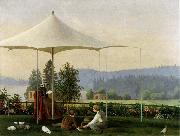 |
Ferdinand von Wright
|
|
1822-1906,Brother of Magnus von Wright and Wilhelm von Wright. He grew up under the influence of his brothers and became a skilled ornithological illustrator at a very young age. He remained in Sweden from 1837 until 1844 and worked as a draughtsman, helping his brother Wilhelm. After returning to Finland he set his sights on a career as a painter. During the second half of the 1840s he was still searching for his proper path, and he experimented with a number of subjects: birds, still-lifes, landscapes and portraits. |
|
 |
FERNANDES, Vasco
|
|
Portuguese painter (active 1500-1542 in Viseu)
Portuguese painter. He was the leading painter of northern Portugal during the first half of the 16th century, and it is probable that he received his training abroad. Fernandes is the best-documented Portuguese artist of the period; there are nearly 100 works attributed to him, some of which are securely documented and record his activity either alone or in collaboration with the Viseu painter GASPAR VAZ. Fernandes's most important work was carried out in Lamego and in Viseu, where the term Gr?o ('Great') used in praise of him is first recorded (Ribeiro Botelho Pereira). In 1753 the Director of the Dresden Gallery, Pietro Guarienti, first used the epithet when he referred to Fernandes by the name of Gran Vasco. The many myths about the painter and his work developed from this date and were not clarified until 1846 |
|
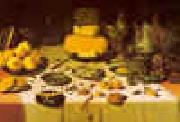 |
Floris van Dijck
|
|
Dutch Baroque Era Painter, 1575-1651
Dutch painter and draughtsman. He is thought to have been a pupil of Rembrandt in Amsterdam c. 1650. There is no documentary evidence for this, but his earliest dated painting, the Presentation in the Temple shows that he had certainly seen examples of Rembrandt work. He was an eclectic artist, given to following several models simultaneously. This is evident from two versions of Elijah and the Widow of Zarephath; one (1655-60; Copenhagen, Stat. Mus. Kst) is painted in horizontal format in the style of Barent Fabritius, while the other (1655-60; Milwaukee, WI, A. Bader priv. col., see Sumowski, 1983, no. 362) features large half-length figures in the manner of Nicolaes Maes. In another biblical scene, Benjamin and Judah (1655-60; Chicago, IL, A. Inst.), he followed the example of Rembrandt. His best works, such as Saying Grace (1655-60; Hannover, Nieders?chs. Landesmus.) and the Old Prophetess (1655-60; Leipzig, Mus. Bild. Kst), show old women either praying or sleeping and confirm that Maes was his main source of inspiration. Similar subjects are represented in the drawings attributed to him (e.g. Old Woman Seated, Holding a Book; New York, Pierpont Morgan Lib.). In the late 1650s van Dijck also seems to have been influenced by the genre paintings of Gabriel Metsu and above all by Quiringh van Brekelenkam, as in Hermit Praying in a Cave (late 1650s; St Petersburg, Hermitage) and Family Saying Grace (late 1650s; Stockholm, Nmus.). |
|
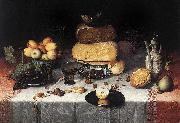 |
Floris van Dyck
|
|
, also called Floris van Dijck or Floris Claesz. van Dyck (Delft or Haarlem, c. 1575 - Haarlem, before 26 April 1651), was a Dutch Golden Age still life painter.
He lived in Haarlem for most of his life, but he was born in Delft. He was a cousin of Pieter Cornelisz van Dijck. In 1600 he is documented as being in Rome, indicating he made a journey to Italy. In 1606 he returned to the Netherlands, where he joined the Haarlem Guild of St. Luke in 1610 and became dean in 1637. He was influenced by Osias Beert and Clara Peeters. He is considered the inventor of the banketje (banquet still life genre similar to breakfasts, or ontbijtjes), together with Nicolaes Gillis. |
|
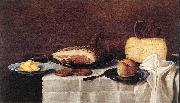 |
Floris van Schooten
|
|
(1590-1655), was a Dutch Golden Age still life painter.
According to the RKD, Van Schooten was the son of a leading Catholic family of Amsterdam who came to live in Haarlem in 1612. During that period, many Catholic families left Amsterdam where the Protestants had the upper hand in local government, for Haarlem, where the climate for Catholicism was more tolerant. The young Van Schooten became a member of the Haarlem Guild of St. Luke and married the daughter of a leading beer brewer there, Rycklant Bol van Zanen. Together they had 3 daughters and a son Johannes, who also became a painter |
|
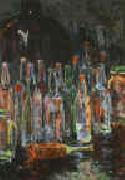 |
Floris Verster
|
|
1861-1927
Dutch
Floris Verster Gallery
Dutch painter. He trained first at the Ars Aemula Naturae school in Leiden under George Hendrik Breitner, then at The Hague Academie (1879-82) and the Brussels Academie (1882). In Leiden in 1882 he started painting landscapes in the style of the Hague school. From 1882 to 1892 he shared a studio in Leiden with the still-life painter Menso Kamerlingh Onnes (1860-1925), who was to become his brother-in-law. Influenced by Onnes and such French realists as Antoine Vollon and Theodule Ribot, in 1885 he turned to painting still-lifes in a mildly Impressionist style that by 1888-9 often attained monumental formats, as in Peonies (1.35*2.00 m, 1889; Amsterdam, Stedel. Mus.). He submitted some of these to exhibitions, where their reception was mixed; artists including Breitner, H. W. Mesdag and Jacob Maris were enthusiastic, but the critics quite often were not. He participated in a few exhibitions abroad, notably from 1890 to 1894 in Munich and in 1891 with Les XX in Brussels. |
|
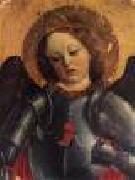 |
FOPPA, Vincenzo
|
|
Italian Early Renaissance Painter, ca.1430-1515
was a Northern-Italian Renaissance painter. He was an elderly contemporary of Leonardo da Vinci. Born at Bagnolo Mella, near Brescia in the Republic of Venice, he settled in Pavia around 1456, serving the dukes of Milan and emerging as one of the most prominent Lombard painters. Foppa returned to Brescia in 1489. His style shows affinities to Andrea del Castagno and Carlo Crivelli. Vasari claimed he had trained in Padua, where he may have been strongly influenced by Mantegna. During his lifetime, he was highly acclaimed, especially for his skill in perspective and foreshortening. His important works include a fresco in the Brera Gallery of Milan, the Martyrdom of St. Sebastian, and a Crucifixion (1435) in the Accademia Carrara of Bergamo. Many of his works have been lost. He was influential in the styles of Vincenzo Civerchio and Girolamo Romanino.
|
|
 |
Francesco Vanni
|
|
Italian Baroque Era Painter, 1563-1610
was an Italian painter of the Mannerist style, active in Rome and his native city of Siena. He was half-brother of the painter Ventura Salimbeni, and the stepson of Arcangelo Salimbeni, another Sienese painter. His stepfather died when Francesco was young, and as a 16 year old went first to Bologna, then to Rome. There he apprenticed with Giovanni de' Vecchi during 1579-80, though like other Tuscan painters of his day, he was influenced in part by Federico Barocci from Urbino, and he was among the last painters who also reflected the influence of the Sienese School of painting. He was named a Cavalieri. In Rome, he worked later with Salimbeni, Bartolomeo Passerotti, and Andrea Lilio. He was commissioned by Pope Clement VIII to painted an altarpiece for the St. Peter's, later transferred to mosaic, Simon Magus rebuked by St. Peter. He painted several other pictures for Roman churches; including St. Michael defeats rebel angels for the sacristy of S. Gregorio; a Piet?? for Santa Maria in Vallicella; and the Assumption for S. Lorenzo in Miranda. Returning to Siena, where he ultimately died, he afterwards worked at Parma, Bologna, and again at Rome. At Siena, he painted a S. Raimondo walking on the Sea for the church of the Dominicans. Vanni painted a Baptism of Constantine (1586-7) for the church of San Agostino in Siena. He painted a Christ appearing to St. Catherine for the chapel of il Refugio at the Santuario Cateriniano of Siena, and a Baptism (1587) for the former church of San Giovannino e Gennaro. |
|
 |
Francesco Vecellio
|
|
(c. 1475 - 1560) was an Italian painter of the early Renaissance, best known as the elder brother of the painter Titian. In his youth, he was a soldier. As a painter, he was mainly active in 1520-1530s in Cadore. In 1524, he signed an altarpiece for San Vito in Cadore. In 1540s, he painted a polyptych at Candide. In late 1540s he painted the organ shutters of San Salvatore in Venice. He painted an Annunciation for San Nicola di Bari, now in the Accademia.
|
|
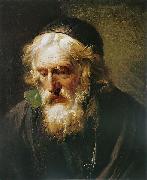 |
Francois-Andre Vincent
|
|
(December 30, 1746 - August 4, 1816) was a French neoclassical painter.
He was the son of the miniaturist François-Elie Vincent and studied under Joseph-Marie Vien. He travelled to Rome, where he won the Prix de Rome in 1768. From 1771 to 1775 he studied there at the Academie de France.
In 1790 Vincent was appointed master of drawings to Louis XVI of France, and in 1792 he became a professor at the Academie royale de peinture et de sculpture in Paris. In 1800 he married the painter Adelaïde Labille-Guiard.
Belisarius by François-Andre Vincent, painted 1776. He was a leader of the neoclassical and historical movement in French art, along with his rival Jacques-Louis David, another pupil of Vien. He was influenced by the art of classical antiquity, by the masters of the Italian High Renaissance, especially Raphael, and among his contemporaries, Jean-Honore Fragonard.
He was one of the founder members of the Academie des beaux-arts part of the Institut de France and the successor to the Academie royale in 1795. |
|
|
|
|
|
|
|
|
|
|

